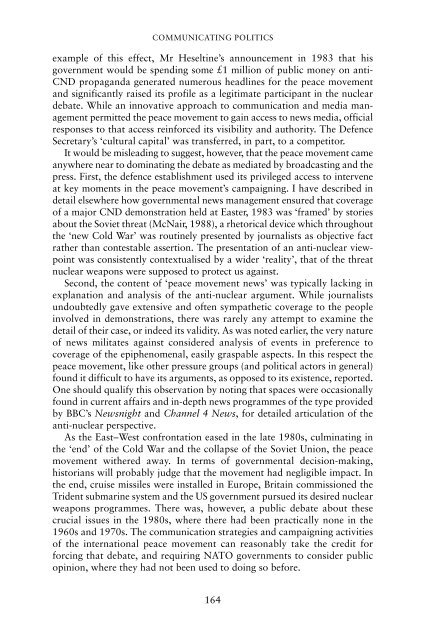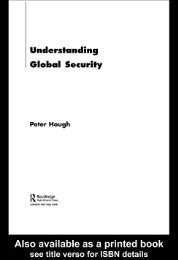20130412164339753295_book_an-introduction-to-political-communication
20130412164339753295_book_an-introduction-to-political-communication
20130412164339753295_book_an-introduction-to-political-communication
Create successful ePaper yourself
Turn your PDF publications into a flip-book with our unique Google optimized e-Paper software.
COMMUNICATING POLITICS<br />
example of this effect, Mr Heseltine’s <strong>an</strong>nouncement in 1983 that his<br />
government would be spending some £1 million of public money on <strong>an</strong>ti-<br />
CND propag<strong>an</strong>da generated numerous headlines for the peace movement<br />
<strong>an</strong>d signific<strong>an</strong>tly raised its profile as a legitimate particip<strong>an</strong>t in the nuclear<br />
debate. While <strong>an</strong> innovative approach <strong>to</strong> <strong>communication</strong> <strong>an</strong>d media m<strong>an</strong>agement<br />
permitted the peace movement <strong>to</strong> gain access <strong>to</strong> news media, official<br />
responses <strong>to</strong> that access reinforced its visibility <strong>an</strong>d authority. The Defence<br />
Secretary’s ‘cultural capital’ was tr<strong>an</strong>sferred, in part, <strong>to</strong> a competi<strong>to</strong>r.<br />
It would be misleading <strong>to</strong> suggest, however, that the peace movement came<br />
<strong>an</strong>ywhere near <strong>to</strong> dominating the debate as mediated by broadcasting <strong>an</strong>d the<br />
press. First, the defence establishment used its privileged access <strong>to</strong> intervene<br />
at key moments in the peace movement’s campaigning. I have described in<br />
detail elsewhere how governmental news m<strong>an</strong>agement ensured that coverage<br />
of a major CND demonstration held at Easter, 1983 was ‘framed’ by s<strong>to</strong>ries<br />
about the Soviet threat (McNair, 1988), a rhe<strong>to</strong>rical device which throughout<br />
the ‘new Cold War’ was routinely presented by journalists as objective fact<br />
rather th<strong>an</strong> contestable assertion. The presentation of <strong>an</strong> <strong>an</strong>ti-nuclear viewpoint<br />
was consistently contextualised by a wider ‘reality’, that of the threat<br />
nuclear weapons were supposed <strong>to</strong> protect us against.<br />
Second, the content of ‘peace movement news’ was typically lacking in<br />
expl<strong>an</strong>ation <strong>an</strong>d <strong>an</strong>alysis of the <strong>an</strong>ti-nuclear argument. While journalists<br />
undoubtedly gave extensive <strong>an</strong>d often sympathetic coverage <strong>to</strong> the people<br />
involved in demonstrations, there was rarely <strong>an</strong>y attempt <strong>to</strong> examine the<br />
detail of their case, or indeed its validity. As was noted earlier, the very nature<br />
of news militates against considered <strong>an</strong>alysis of events in preference <strong>to</strong><br />
coverage of the epiphenomenal, easily graspable aspects. In this respect the<br />
peace movement, like other pressure groups (<strong>an</strong>d <strong>political</strong> ac<strong>to</strong>rs in general)<br />
found it difficult <strong>to</strong> have its arguments, as opposed <strong>to</strong> its existence, reported.<br />
One should qualify this observation by noting that spaces were occasionally<br />
found in current affairs <strong>an</strong>d in-depth news programmes of the type provided<br />
by BBC’s Newsnight <strong>an</strong>d Ch<strong>an</strong>nel 4 News, for detailed articulation of the<br />
<strong>an</strong>ti-nuclear perspective.<br />
As the East–West confrontation eased in the late 1980s, culminating in<br />
the ‘end’ of the Cold War <strong>an</strong>d the collapse of the Soviet Union, the peace<br />
movement withered away. In terms of governmental decision-making,<br />
his<strong>to</strong>ri<strong>an</strong>s will probably judge that the movement had negligible impact. In<br />
the end, cruise missiles were installed in Europe, Britain commissioned the<br />
Trident submarine system <strong>an</strong>d the US government pursued its desired nuclear<br />
weapons programmes. There was, however, a public debate about these<br />
crucial issues in the 1980s, where there had been practically none in the<br />
1960s <strong>an</strong>d 1970s. The <strong>communication</strong> strategies <strong>an</strong>d campaigning activities<br />
of the international peace movement c<strong>an</strong> reasonably take the credit for<br />
forcing that debate, <strong>an</strong>d requiring NATO governments <strong>to</strong> consider public<br />
opinion, where they had not been used <strong>to</strong> doing so before.<br />
164
















